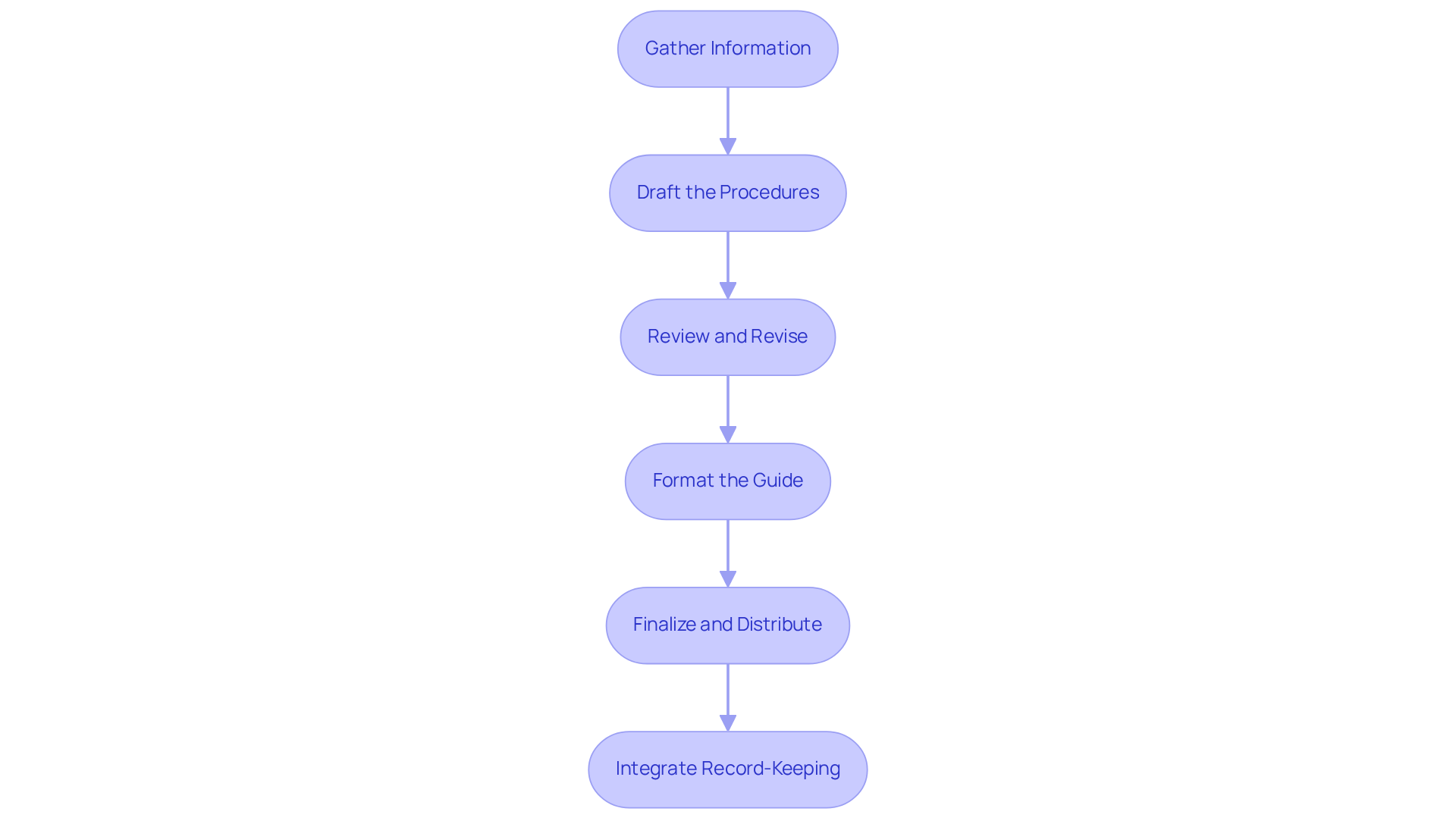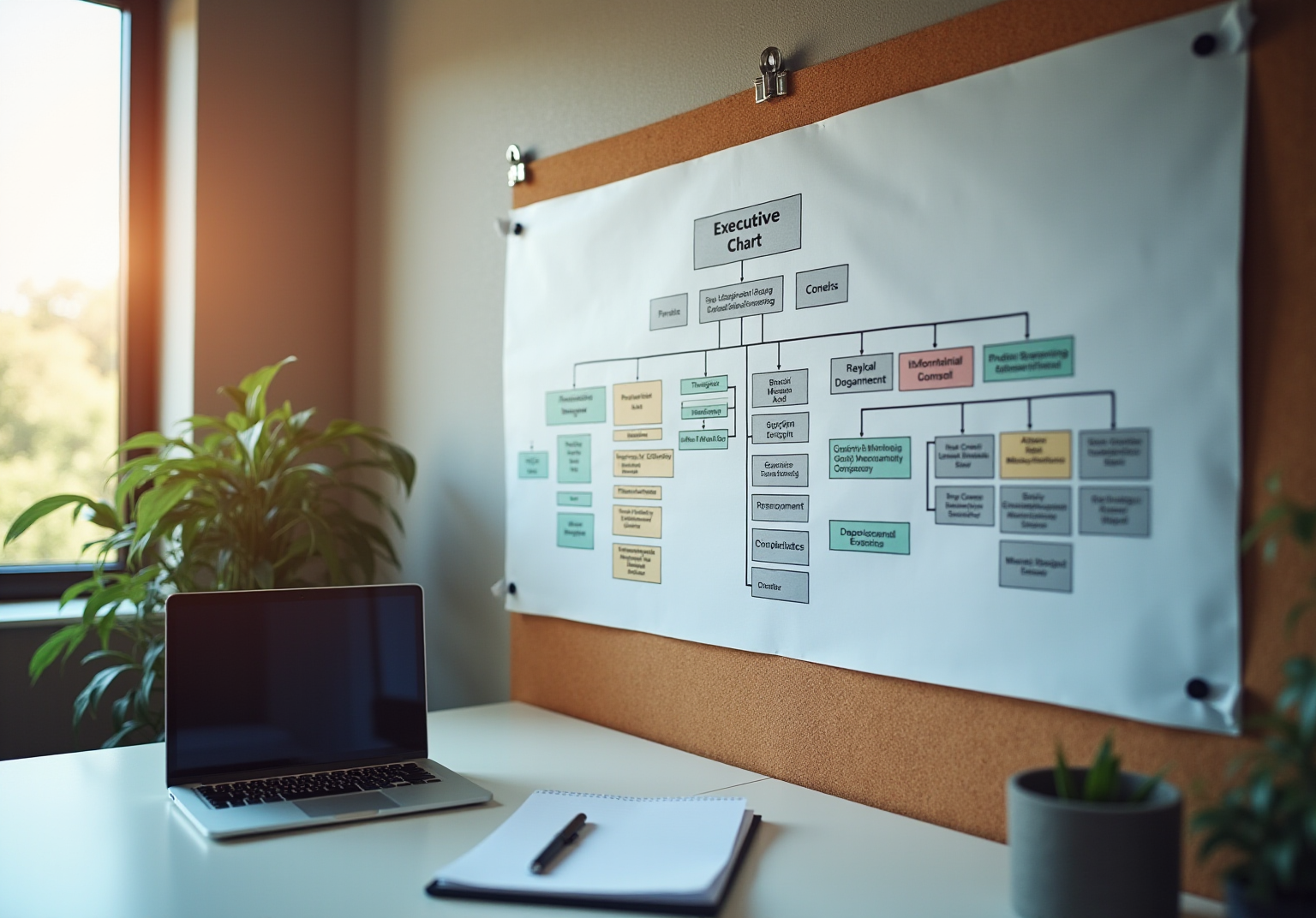
Overview
You might be wondering how to write a procedure manual that really works. Well, it’s all about focusing on a few key things! First off, clarify the manual's purpose. What do you want it to achieve? Next, gather all the relevant information you can find. This is where you’ll want to draft clear procedures that everyone can follow. And don’t forget to set up a maintenance schedule for updates—keeping things fresh is crucial!
Now, let’s dive into some essential steps. Identifying your target audiences and expected outcomes can really enhance employee efficiency and compliance. Think about it: well-structured guidelines make everyone's life easier! So, as you work on your manual, keep these points in mind to create something that not only informs but also engages your team.
Key Highlights:
- Clarifying the purpose of a procedure manual involves identifying processes, understanding the target audience, and defining expected outcomes.
- Key aspects to consider include onboarding procedures, safety protocols, and ensuring the manual meets user needs.
- Essential steps for writing a procedure manual include gathering information, drafting clear procedures, reviewing and revising, formatting the guide, and finalising for distribution.
- A well-structured manual enhances employee efficiency and compliance by providing clear guidelines.
- Establishing a maintenance schedule is crucial, including setting review intervals, assigning responsibility, updating procedures, communicating changes, and soliciting feedback.
- Regular reviews and updates ensure the manual remains relevant and effective, contributing to operational efficiency.
Introduction
Creating a procedure manual isn’t just another task on your to-do list; it’s a smart move that can really boost your organization’s efficiency and compliance. You might be wondering how that works. By clearly defining processes and responsibilities, operations managers can streamline workflows and cut down on errors. But here’s the kicker: the real challenge is figuring out how to put together and keep this essential document up to date.
So, what are the key elements that make a procedure manual not just useful, but absolutely indispensable in today’s fast-paced work environment? Let’s dive into that!
Define the Purpose of a Procedure Manual
Clarifying the purpose of how to write a procedure manual is a crucial first step in its development. You might be wondering, what exactly should I focus on? Let’s break it down into a few key aspects:
- Identify the Processes: First off, think about which specific operations or tasks need documentation. This could be anything from onboarding procedures to safety protocols. The goal here is to ensure that all essential functions are covered.
- Target Audience: Next, let’s clarify who will be using the guide. Is it for new hires, current employees, or maybe even external partners? Understanding your audience helps tailor the content to their needs, making it way more user-friendly.
- Expected Outcomes: Now, take a moment to reflect on what you hope to achieve with the guide. Will it streamline operations, reduce errors, or help with training? Having a clear purpose not only directs the content and structure but also lays the groundwork for evaluating how effective the document is.
By tackling these questions, you can understand how to write a procedure manual that is focused and purposeful, truly meeting the needs of its users. A well-defined purpose can significantly boost employee efficiency, providing clear guidelines and expectations that lead to better compliance and operational consistency.
Speaking of making things easier, tools like SowFlow can really enhance this process. They allow for effortless user guide creation and instant updates, keeping your materials relevant and accessible. Plus, SowFlow’s features help cut down on unnecessary meetings and improve knowledge sharing, making it a breeze for operations managers to handle their documentation efficiently.

Outline Key Steps for Writing a Procedure Manual
Do you need to learn how to write a procedure manual? It might seem daunting, but it doesn’t have to be! Let’s break it down into some essential steps on how to write a procedure manual that will help you create something clear and effective.
-
Gather Information: You’ll want to team up with your colleagues who actually do the tasks. Chat with them, observe their work, and dig into any existing documents. These are goldmines of information!
-
Draft the Procedures: Now, it’s time to put pen to paper (or fingers to keyboard). Write clear and concise instructions for each process. Keep your language simple and use an active voice to make it easy to read. Here’s what to include:
- Title: Make sure the procedure’s name is front and center.
- Purpose: Give a quick rundown of why knowing how to write a procedure manual is important.
- Scope: Who is this for in terms of learning how to write a procedure manual? When discussing how to write a procedure manual, it is important to specify the audience and any limits.
- Responsibilities: Understanding how to write a procedure manual will help clarify who’s in charge of what. Be clear about how to write a procedure manual that outlines accountability.
- Steps: When considering how to write a procedure manual, lay out the steps in a logical order. Understanding how to write a procedure manual can greatly enhance clarity.
- References: Don’t forget to add any related documents or resources that support your procedure.
-
Review and Revise: Once you’ve got a draft, share it with your stakeholders. To ensure everything’s spot on, get feedback from subject matter experts on how to write a procedure manual. This is crucial for making sure your manual effectively demonstrates how to write a procedure manual as a reliable resource. Revise based on their insights.
-
Format the Guide: Next up, make it look good! Organize your guide on how to write a procedure manual in a user-friendly way. Think about using headings, subheadings, and a table of contents to help folks find what they need quickly.
-
Finalize and Distribute: After polishing it up, it’s time to share your masterpiece with everyone who needs it. Make sure they know where to find it and how to use it effectively. This step is key to building a culture of compliance and efficiency in your organization.
And hey, integrating efficient record-keeping methods can really cut down on those unproductive meetings. Did you know that 65% of professionals say meetings get in the way of finishing tasks? Tools like Scribe and Bit.ai can streamline your documentation workflow, making it easier to create and maintain guidelines. As Saravana Kumar puts it, "SOPs help ensure tasks are performed correctly and consistently to meet specifications and deliver quality outcomes." So, why not give it a shot?

Establish a Maintenance Schedule for Your Manual
To keep your procedure manual effective, understanding how to write a procedure manual with a solid maintenance schedule is super important. Let’s break it down:
-
Set Review Intervals: You might be wondering how often you should review your manual. Well, it can be anywhere from quarterly to annually, depending on how frequently your procedures change. Regular reviews are key when learning how to write a procedure manual! Organizations that have a systematic approach to policy management often find they save on legal costs and boost compliance. Experts usually suggest reviewing policies every year, but some say intervals of one to three years can work too.
-
Assign Responsibility: Who’s in charge of this review process? Designating a specific team or individual can make all the difference. This accountability helps ensure that when considering how to write a procedure manual, your manual remains consistent and thorough, which is a best practice in policy management.
-
Update Procedures: During each review, it is important to understand how to write a procedure manual that assesses the accuracy and relevance of your procedures. Is there any outdated info? Make sure to update it and add in any new processes that are necessary. Research shows that organizations that keep their documentation fresh can really boost operational efficiency and cut down on confusion among team members.
-
Communicate Changes: Once you’ve made updates, it’s time to spread the word! Let all users know about the changes. A change log can be a handy tool to document revisions and ensure everyone is on the same page with the latest procedures. This fosters a culture of transparency and collaboration.
-
Solicit Feedback: Don’t forget to ask users for their thoughts on the manual’s usability and effectiveness. Gathering feedback is crucial for continuous improvement and can lead to smoother processes, ultimately saving time and boosting productivity.
Now, let’s dive into how you can make these steps work for you!

Conclusion
Creating a procedure manual? It’s a pretty essential task for operations managers, right? Think of it as your go-to guide that boosts efficiency and keeps everything compliant. By defining the purpose, outlining key steps, and setting up a maintenance schedule, you can make sure your manuals stay relevant and effective. Plus, focusing on clarity and user-friendliness not only helps onboard new employees but also builds a culture of consistency and accountability throughout the organization.
You might be wondering what steps are involved in writing a procedure manual. Well, here’s the scoop:
- Gather information from your team
- Draft clear instructions
- Review and revise the content
- Format the guide for easy use
- Finalize it for distribution
And don’t forget about regular maintenance and updates! Keeping the manual up-to-date ensures it reflects the latest practices and procedures, which is key to supporting operational efficiency.
So, in a nutshell, putting time and effort into creating and maintaining a solid procedure manual is crucial for any organization looking to streamline operations and enhance training. By following best practices and using tools designed for documentation, you can cut down on errors, boost compliance, and make workflows smoother. Embracing this approach not only helps your team but also contributes to the overall success of the organization. It’s definitely a worthwhile endeavor for any operations manager!
Frequently Asked Questions
What is the first step in developing a procedure manual?
The first step is to clarify the purpose of the manual, which involves identifying the specific processes or tasks that need documentation.
How do I determine which processes need to be documented?
You should consider all essential functions that require documentation, such as onboarding procedures or safety protocols.
Who is the target audience for a procedure manual?
The target audience could include new hires, current employees, or external partners. Understanding your audience helps tailor the content to their needs.
What are the expected outcomes of creating a procedure manual?
Expected outcomes may include streamlining operations, reducing errors, and assisting with training. A clear purpose helps direct the content and evaluate the document's effectiveness.
How can a well-defined purpose in a procedure manual benefit employees?
A well-defined purpose can boost employee efficiency by providing clear guidelines and expectations, leading to better compliance and operational consistency.
What tools can assist in creating a procedure manual?
Tools like SowFlow can enhance the process by allowing for easy user guide creation and instant updates, improving knowledge sharing and reducing unnecessary meetings.
👍
What others are liking
5 Steps to outline your ideal documentation structure
5 MINS READ
Where to start the your journey of mapping out your ideal documentation structure, aligning it with the very heartbeat of your organization?
Defining a winning level of detail in your process
3 MINS READ
What is too much detail, and what is too little? This article described in that winning level detail about what detail is enough.





